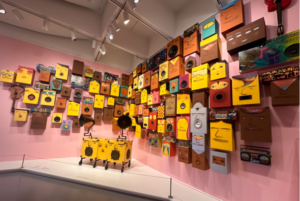Rome School Performs Original Play “Girlhood”

Image Courtesy of Allie Macdonald
By Noah Slayter
“There’s no more chasing rainbows and hoping for an end to them. Their arches are illusions, solid at first glance. But then you try to touch them. There’s nothing to hold on to. The colors used to lure you in. And put you in a trance.” – Lana Del Rey’s Get Free.
The Rome School’s performance of “Girlhood” was a coquettish deluge into the female adolescent experience. Written by Dani Stoller, an MFA student at Catholic U, and performed April 5-7 of this year. Girlhood strives to explain what it means to be a girl without being too overt about it.
The show is made up of a series of vignettes, with each displaying a scene that would resonate with the vast majority of girls in America. There are scenes involving common young adult conflicts, such as figuring out what college to attend or sneaking out to meet a boy.
Image Courtesy of Allie Macdonald
The script had a realistic quality – something hard to attain with informal dialogue, as “trendy” writing attempting to reach the casual slang of younger generations often comes across as condescending and Disney Channel-esque. Stoller’s book achieves this same casual tone but without sacrificing the emotion.
Directed by Ian Anthony Coleman, this is his directorial debut on a CUA stage. He said the show reminded him of Lana Del Rey’s song “Get Free.”
The initial impact of the show was worrisome. The set was minimal and random, with pieces of furniture taped to poles and walls. However, as the show continued, its reason became apparent. The show takes place underneath a highway overpass, so the randomized furniture reflects this.
However, the overall setting seemed more intentional. The chaotic randomness of Coleman’s design was juvenile – but perhaps, so is girlhood.
The ensemble cast had an emotionally raw approach in their acting, which hinted at the reality of their scenes. Each scene felt like it could actually happen, which serves as another round of applause for Stoller’s script. The scenes felt dramatized but not unrealistic, resembling a modern version of Thorton Wilder’s “Our Town.”
Each actor’s genuine passion was palpable. With that said, the vignettes are so relatable—the scenes so lifelike—that connecting with their everymen characters was likely not a stretch.
From the ensemble, one actress stood out: Abigail Aronne, who played a myriad of roles with varying personalities. From nerd to drunk college student, Aronne’s array of characters were both distinct and full of pith. Her lines were delivered with sentiment that demonstrated her underlying power.
Aronne’s various on-stage episodes culminated in the play’s ending scene. Her character, Gemma, just left the funeral for her dead mother. She, along with two other female friends, contemplate what comes after death – is it an endless drop in the bucket of existence or a heavenly beatific vision? Breaking into tears, Gemma decides to believe that regardless of “where” her mother is, she knows part of her mother lives on inside her.
When asked about her experience playing Gemma, Aronne said she was “someone who relates very personally” to her grieving character.
As Aronne lost her own mother connecting to Gemma’s experience was “truly an honor,” she said.
“Losing a parent in your teens is scary and confusing,” the actress said. “It’s hard to know where to turn.”
Confiding in friends, Aronne said, just as Gemma does, can be the support you need to “navigate this world.”
Aronne commented that Gemma was “able to find that her mom’s spirit still lives on.” (This comment was perhaps not just referring to Gemma, but Aronne as well.)





